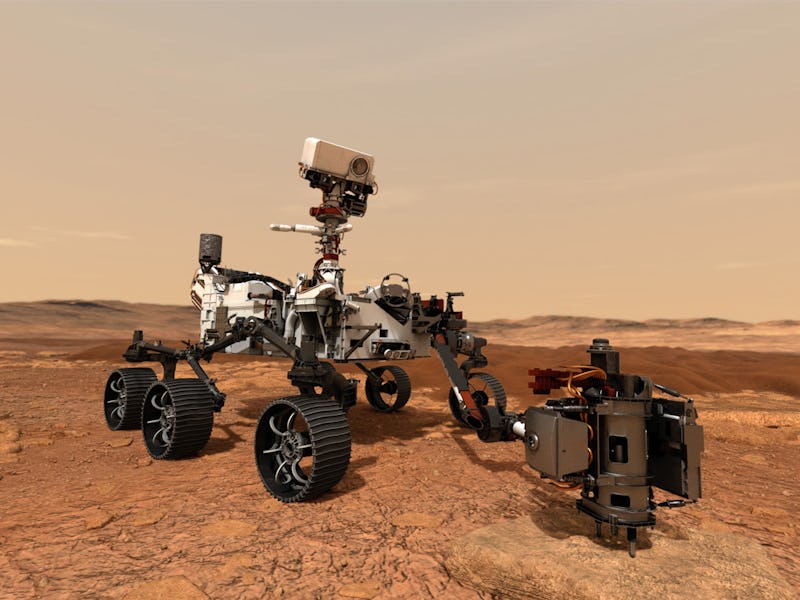6 essential facts about Perseverance's trailblazing Mars mission
It's been a long journey for this robotic astrobiologist.

In July 2020, a robotic astrobiologist began a journey to a distant planet. NASA's Perseverance rover is currently en route to Mars — set to land on the Red Planet by February 2021.
The mission is seven years in the making and will allow unprecedented exploration of Mars, which may have hosted life billions of years ago.
READ MORE PERSEVERANCE ROVER NEWS FROM INVERSE
Before Perseverance lands on the dusty planet, get familiar with the car-sized robot, its unique abilities, and why it's capable of exploring ancient alien life.
What will Perseverance do on Mars?
The goal of the Perseverence is to look for clues of ancient life on Mars. These clues may help scientists understand the history of the planet, which is hypothesized to have once been a wet, habitable world. The rover will also collect Martian samples, stowing them away for a future return to Earth.
Here is how the robot will go about its 687-day mission on Mars, the equivalent of one Martian year.
1. Perseverance is landing in the Jezero Crater
Perseverance's destination is the Jezero Crater, a 500-meter-deep crater located in a basin slightly north of the Martian equator. Jezero Crater once housed a lake estimated to have dried out 3.5 to 3.8 billion years ago, which makes it an ideal destination to hunt for ancient, microbial life that may have once existed on Mars.
2. Perseverance will undergo "seven minutes of terror'"
The entry and landing of the Perseverance rover on Mars are referred to as the "seven minutes of terror." That's how long it takes for the rover to get from the top of the Martian atmosphere and down to the surface. It then takes an additional 14 minutes for the team to receive a signal from the rover on Mars, considering there's a lag since Mars is millions of miles away.
3. Perseverance is looking for ancient microbial life
Once on Mars, the rover will look for signs of habitability on the Martian surface and past microbial life — collecting samples of rocks and soil and setting them aside for the first-ever sample return mission from another planet. It will collect at least 20 samples from Mars using a handy drill attached to the robot's arm. The rock samples will be stored away in tubes in a well-identified place on the Martian surface and left there to be returned to Earth.
4. Perseverance isn't going at it alone
Perseverance isn't venturing to Mars on its own. The Ingenuity helicopter will hitch a ride with the rover, allowing NASA to test out its ability to fly a helicopter on a planet other than Earth for the first time. After it detaches itself from the rover, Ingenuity will fly solo in a series of test flights.
5. Perseverance has a top-of-the-line toolset
The rover carries a highly skilled team of detectives on board: instruments known as S.H.E.R.L.O.C., (Scanning Habitable Environments with Raman & Luminescence for Organics & Chemicals) and WATSON, Wide Angle Topographic Sensor for Operations and eNgineering instrument. These will look for microscopic clues in Martian rock.
6. Perseverance will lay the groundwork for human exploration
The mission will also test out conditions for possible human exploration of Mars by trialing a method of producing oxygen from the Martian atmosphere, characterizing environmental conditions such as water and dust on Mars, and looking for resources.
Perseverance will land on Mars on February 18, 2021. It will join the Curiosity rover, which landed on Mars in August 2012 and is still roaming the Red Planet today.
This article was originally published on